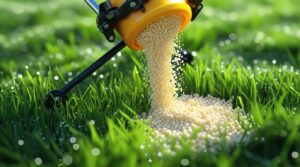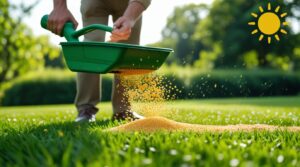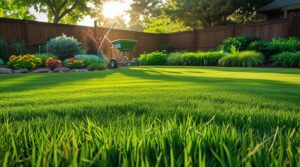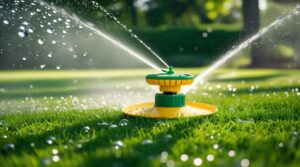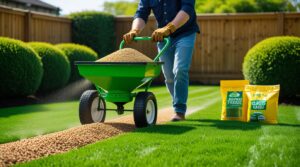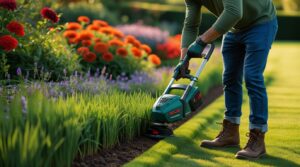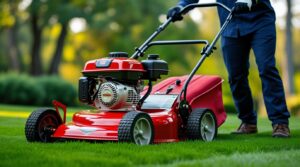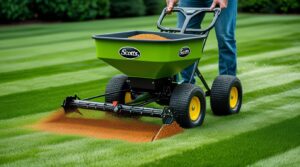Looking for the best lawn fertilizer for spring? You’re in the right place! A lush, green lawn starts with smart spring care, and fertilizer plays the most vital role.
Springtime! Just saying the word makes us think of sunny skies, blooming flowers, and that fresh, vibrant feeling in the air. But if you’re a homeowner, especially one passionate about having a gorgeous lawn, springtime means one thing above all else: lawn fertilization.
After a cold and dormant winter, your lawn wakes up hungry and eager to grow. Fertilizing your grass at this crucial time provides it with the essential nutrients it needs to kickstart growth, giving you the lush, thick, emerald-green lawn you’ve always dreamed of. Spring fertilization isn’t just about immediate beauty—it’s about setting the stage for strong, healthy grass that thrives all season long.
In this article, I’ll guide you step-by-step through the best lawn fertilizer for spring. Ready to get your lawn off to the perfect start this spring? Let’s dive right in!
Why is Spring the Best Time to Fertilize Your Lawn?
Spring is nature’s wake-up call—especially for your lawn. After months of chilly temperatures and dormant conditions, your grass is just beginning to stir back to life. This seasonal transition marks one of the most critical periods in your lawn care routine, making spring fertilization vital for achieving a lush, green yard.
Grass Dormancy and Awakening in Spring
During winter, grass becomes dormant—growth slows down significantly, and the grass blades turn brown and lifeless-looking. While this dormant period protects your lawn from harsh winter conditions, it leaves the grass hungry and nutrient-depleted once the temperatures start to rise.
As the weather warms up, your lawn begins a natural awakening process. Grass roots actively search for nutrients to jump-start growth, re-establish green foliage, and develop deeper, healthier roots. This crucial stage is exactly why timely spring fertilization makes all the difference.
Benefits of Early-Season Fertilization
Applying fertilizer at the right time in spring sets your lawn up for success by offering these incredible benefits:
- Improved Growth
Spring fertilizers are typically high in nitrogen, a nutrient essential for rapid leaf growth. Fertilizing your lawn in early spring promotes thicker grass coverage, lush green blades, and deeper roots, giving your yard an attractive appearance from the get-go. - Weed Prevention
A strong, well-fed lawn naturally resists weeds. Fertilizing early helps grass fill in thin or bare patches quickly, leaving fewer opportunities for pesky weeds like crabgrass, dandelions, and clover to take hold. You’ll spend less time battling weeds and more time enjoying your beautiful yard. - Disease Resistance
A well-nourished lawn isn’t just attractive—it’s healthier, too. Fertilizing your grass in spring strengthens it, making it more resistant to common lawn diseases like brown patch, dollar spot, and rust. Think of it as boosting your lawn’s immune system to ensure healthier growth year-round. - Stress Tolerance (Heat and Drought)
Spring fertilization helps your lawn build resilience to upcoming challenges like scorching summer heat and drought conditions. By providing nutrients at the start of the season, your lawn develops stronger, deeper roots, enabling it to access moisture and nutrients even in tough conditions.
Understanding Lawn Nutrients: N-P-K Explained
When choosing the best lawn fertilizer for spring for your lawn, you’ll frequently encounter three crucial letters: N-P-K. Understanding what these letters mean and why they matter is essential for giving your lawn exactly what it needs to thrive.
What is N-P-K?
The letters N-P-K represent the three major nutrients your grass requires—Nitrogen (N), Phosphorus (P), and Potassium (K). Each of these nutrients has a specific role in lawn health, growth, and resilience:
Nitrogen (N): For Lush Green Growth
- Nitrogen is the superstar nutrient responsible for that vibrant, lush green color in your lawn.
- It promotes strong leaf and blade growth, quickly transforming a tired-looking lawn into a thick carpet of green.
- Ideal for spring since your grass needs extra help recovering from winter dormancy and greening up rapidly.
Phosphorus (P): Root Growth and Strength
- Phosphorus helps your lawn develop deep, strong roots.
- Essential for new lawns or lawns being re-seeded, as it supports rapid establishment and root system development.
- Established lawns usually need lower phosphorus levels, but small amounts can still significantly boost root health.
Potassium (K): Overall Health and Stress Tolerance
- Potassium acts like a protective shield for your lawn, helping it handle environmental stresses such as drought, extreme temperatures, and disease.
- Strengthens cell walls, improves water retention, and enhances overall lawn resilience.
- Especially important in spring as grass transitions to warmer, potentially stressful conditions ahead.
Ideal N-P-K Ratios Specifically for Spring
Choosing the right N-P-K ratio is crucial because your lawn’s nutrient needs change throughout the year. Here are the most common and effective spring fertilizer ratios to help you make the best choice:
- 16-0-8:
- Higher nitrogen promotes rapid green-up and leaf growth.
- Zero phosphorus means it’s perfect for established lawns and does not require additional root support.
- Ideal balance of potassium for general lawn resilience.
- 14-7-14:
- Excellent balanced fertilizer for new lawns or lawns needing root strengthening.
- Good choice if your lawn has experienced winter damage or thinning.
- Promotes both lush top-growth and deeper, stronger roots.
- 20-2-3:
- Very high nitrogen content, great for established lawns needing a significant spring growth boost.
- Low phosphorus is suitable for lawns that already have well-developed roots.
- Moderate potassium for general health and stress management.
Recommended Ratios for Different Lawn Types
Selecting the ideal fertilizer ratio depends largely on the type of grass you have and its specific needs:
- Cool-season grasses (Kentucky Bluegrass, Ryegrass, Fescue):
- Typically benefit from higher nitrogen fertilizers (16-0-8 or 20-2-3) for rapid spring green-up.
- Use a balanced fertilizer (14-7-14) for thin or damaged cool-season lawns to boost root strength.
- Warm-season grasses (Bermuda, Zoysia, St. Augustine, Centipede):
- Thrive best with balanced fertilizers (14-7-14) or slightly lower nitrogen and higher potassium (12-0-24) to manage stress and support steady growth throughout spring and into summer.
Pro tip: Always consider a simple soil test before picking your fertilizer. This test will show you exactly what your lawn needs, eliminating guesswork and ensuring you achieve perfect results.
Types of Best Lawn Fertilizer for Spring
When it comes to spring fertilization, choosing the right type of fertilizer makes a huge difference in how your lawn grows. There are two main types of fertilizers you’ll come across: Granular and Liquid. Each has unique advantages and disadvantages, and knowing the difference helps you pick the best one for your lawn care needs.
Granular Fertilizers
Granular fertilizers come as dry pellets or granules. They’re extremely popular among homeowners and beginner lawn enthusiasts because they’re simple to apply and provide consistent results over time.
Advantages of Granular Fertilizers:
- Ease of Use:
Granular fertilizers are beginner-friendly. Simply fill up your spreader, adjust the setting, and walk across your lawn—it’s that straightforward. - Slow-Release Nutrients:
They provide nutrients steadily over several weeks or months. This ensures consistent growth, deeper roots, and prolonged greenness without frequent applications. - Long Shelf Life:
They store easily, maintaining potency over extended periods. If you have leftover fertilizer, you can save it for the next application.
Disadvantages of Granular Fertilizers:
- Slower Results:
Granular fertilizers typically take longer (around 5-7 days) to show visible results compared to liquids. - Uneven Spreading Risk:
Without careful application, granular fertilizers can result in uneven nutrient distribution, causing patches of thicker or thinner growth.
Liquid Fertilizers
Liquid fertilizers come in concentrated formulas that you mix with water. Lawn enthusiasts who love precision and quick results usually prefer liquid options.
Advantages of Liquid Fertilizers:
- Quick Results:
Liquid fertilizers are rapidly absorbed, often showing results in just 1–3 days, quickly giving your lawn a lush green appearance. - Even Coverage:
Liquid fertilizers spread evenly across your grass, reducing the chances of missed spots or patchy growth. - Enhanced Precision:
Easy to adjust and apply specific nutrients precisely based on your lawn’s immediate needs.
Disadvantages of Liquid Fertilizers:
- Requires Precision:
An application needs more accuracy. Over-applying can burn the grass, and under-applying may limit growth benefits. - Frequent Application:
Liquid fertilizers generally have shorter effectiveness periods, requiring more frequent applications (every 2–4 weeks). - Shorter Shelf Life:
Once mixed, liquid fertilizers typically can’t be stored for extended periods without losing effectiveness.
Comparison Chart: Granular vs Liquid Fertilizers
| Features | 🌱 Granular Fertilizer | 💦 Liquid Fertilizer |
| Ease of Application | Very Easy | Moderate (Requires precision) |
| Speed of Results | 5–7 Days | 1–3 Days |
| Coverage Uniformity | Risk of uneven spreading | Very even |
| Nutrient Release | Slow, steady (weeks/months) | Fast, immediate (days/weeks) |
| Application Frequency | Less frequent (every 6–8 weeks) | More frequent (every 2–4 weeks) |
| Risk of Burning Grass | Lower | Higher if misapplied |
| Storage & Shelf Life | Excellent, stores easily | Shorter shelf life once mixed |
| Best Suited For | Beginners, large lawns | Experienced users, precise feeding |
How to Choose the Best Lawn Fertilizer for Spring Based on Grass Type
Not all lawns are the same, and neither are their fertilizer needs. Choosing the ideal spring fertilizer depends heavily on your specific grass type. Let’s break down exactly what fertilizers to use, along with application tips, for the two primary categories: Cool-season grasses and Warm-season grasses.
Cool-season Grasses
Cool-season grasses, such as Kentucky Bluegrass, Perennial Ryegrass, and Fescues, thrive best in moderate climates. These grasses grow vigorously in the cooler temperatures of spring and fall, making proper spring fertilization critical for robust growth.
Ideal Fertilizers for Cool-Season Grasses:
- High Nitrogen Fertilizers:
Choose fertilizers with higher nitrogen content for rapid green-up, such as:- Scotts Turf Builder Triple Action (16-0-8)
- Humic Max (16-0-8) (great for deep green color)
- Complete 14-7-14 (if your lawn needs root support and an overall health boost)
- Slow-release Formulas:
Granular, slow-release fertilizers are best since they deliver nutrients gradually, preventing rapid, weak growth and ensuring steady nourishment.
Application Tips:
- Apply fertilizer when soil temperature consistently reaches around 50-55°F, usually early to mid-spring.
- Use a broadcast spreader for even distribution, aiming for 3 lbs of fertilizer per 1000 sq. ft.
- Water your lawn lightly immediately after application to help nutrients penetrate into the soil.
- Follow up with another lighter feeding 6-8 weeks after initial fertilization to maintain lush growth throughout spring.
Warm-season Grasses
Warm-season grasses, like Bermuda, St. Augustine, Zoysia, and Centipede, flourish in warmer climates and begin vigorous growth as spring temperatures rise above 65°F.
Ideal Fertilizers for Warm-Season Grasses:
- Balanced and Potassium-Rich Fertilizers:
Fertilizers with moderate nitrogen and higher potassium content provide the ideal nutrients to encourage growth and enhance stress tolerance:- Scotts Turf Builder Southern Triple Action (29-0-10) (includes weed & fire-ant control)
- Stress 12-0-24 by Lebanon Turf (high potassium for stress tolerance)
- Complete 14-7-14 (balanced fertilizer, great for general spring feeding and root health)
- Fast-acting Liquid Fertilizers:
Liquid fertilizers (e.g., Mirimichi Green Release 901C) offer quick nutrient absorption, perfect for lawns needing immediate green-up and recovery from winter stress.
Application Methods:
- Begin fertilizing warm-season grasses when soil temperatures consistently exceed 60-65°F, usually in late spring.
- For granular fertilizers, evenly distribute about 3-4 lbs per 1000 sq. ft using a broadcast spreader, and immediately water in deeply to activate the nutrients.
- For liquid fertilizers, apply evenly using a hose-end sprayer. Apply in the early morning or evening to prevent evaporation or potential burn.
- Warm-season grasses typically benefit from multiple lighter feedings (every 4–6 weeks) throughout spring and summer to maintain steady, healthy growth.
Quick Summary (Cool-season vs Warm-season)
| Grass Type | Ideal Fertilizer Types | Application Timing | Application Frequency |
| Cool-season Grasses | High nitrogen, slow-release (16-0-8, 14-7-14) | Early to Mid Spring (50°F+) | Every 6–8 weeks |
| Warm-season Grasses | Balanced or high potassium (12-0-24, 14-7-14) | Late Spring (65°F+) | Every 4–6 weeks |
Top 7 Best Lawn Fertilizers for Spring (Detailed Reviews)
Spring fertilization is a game-changer when aiming for a lush, green, envy-worthy lawn. Here, I’ve handpicked and reviewed the ideal top 7 best lawn fertilizers for springtime, complete with detailed benefits, recommended grass types, and clear usage instructions. Let’s dive in!
1️⃣ Scotts Turf Builder Triple Action
(Best for Northern Lawns – Weed Control + Fertilizer)
- ✅ NPK Ratio: 16-0-8
- ✅ Key Benefits:
- Feeds and strengthens grassroots, promoting lush green growth.
- Kills existing broadleaf weeds like dandelions and clover.
- Prevents crabgrass growth for up to 4 months.
- ✅ Grass Types: Kentucky Bluegrass, Perennial Ryegrass, Fescues
- ✅ Usage Instructions:
- Apply in early spring (when dandelions first appear).
- Use a spreader for even application (approx 3 lbs per 1000 sq. ft).
- Lightly water afterward to activate weed control ingredients.
2️⃣ Scotts Turf Builder Southern Triple Action
(Best for Southern Lawns – Fire Ant Control + Fertilizer)
- ✅ NPK Ratio: 29-0-10
- ✅ Key Benefits:
- Feeds lawns with high nitrogen for vibrant green color.
- Kills stubborn southern weeds, such as dollarweed and clover.
- Controls and prevents fire ants for up to 6 months.
- ✅ Grass Types: Bermuda, St. Augustine, Centipede, Zoysia
- ✅ Usage Instructions:
- Apply when lawn emerges from dormancy (late spring, 65°F+).
- Evenly distribute (3–4 lbs per 1000 sq. ft).
- Water immediately after application for best results.
3️⃣ Lebanon Turf Stress 12-0-24
(High Potassium for Stress Tolerance)
- ✅ NPK Ratio: 12-0-24
- ✅ Key Benefits:
- High potassium promotes stress tolerance, aiding lawns during temperature fluctuations and drought.
- Slow-release nitrogen supports steady growth without the risk of burning.
- Contains iron for enhanced color and density.
- ✅ Grass Types: Ideal for both cool and warm-season grasses (particularly stressed lawns)
- ✅ Usage Instructions:
- Apply in early to mid-spring.
- Spread evenly at a rate of about 3 lbs per 1000 sq. ft.
- Water lightly after application.
4️⃣ Humic Max 16-0-8
(Balanced N-K Ratio, Ideal for Green-up)
- ✅ NPK Ratio: 16-0-8
- ✅ Key Benefits:
- Promotes rapid green-up with balanced nitrogen and potassium.
- Includes humic acid, enhancing soil quality and nutrient uptake.
- Delivers a long-lasting, deep green color without excessive growth.
- ✅ Grass Types: Suitable for all lawn types (excellent for Kentucky Bluegrass, Ryegrass, and Fescues)
- ✅ Usage Instructions:
- Apply evenly in early spring (soil temperatures around 55°F).
- Use a broadcast spreader (3 lbs per 1000 sq. ft).
- Water thoroughly after application.
5️⃣ Complete 14-7-14
(Good Starter Fertilizer for Root Growth)
- ✅ NPK Ratio: 14-7-14
- ✅ Key Benefits:
- Ideal starter fertilizer to support root growth and establishment.
- Balanced macro and micronutrients (including sea kelp and humic acid) to promote overall lawn health.
- Provides steady, balanced growth without sudden spikes.
- ✅ Grass Types: Excellent for newly seeded or sodded lawns (both cool and warm-season grasses)
- ✅ Usage Instructions:
- Apply during early spring or after reseeding.
- Distribute fertilizer evenly (approx 3–4 lbs per 1000 sq. ft).
- Water lightly immediately after application.
6️⃣ Mirimichi Green Release 901C (Liquid)
(Quick Absorption & Visible Results)
- ✅ NPK Ratio: 9-0-1
- ✅ Key Benefits:
- Rapidly absorbed nutrients show visible greening within days.
- Includes carbon and biostimulants to enhance nutrient availability and soil aeration.
- Improves drought and heat tolerance significantly.
- ✅ Grass Types: All types (ideal for experienced lawn care enthusiasts)
- ✅ Usage Instructions:
- Mix concentrate as directed with water.
- Apply using a hose-end sprayer evenly across the lawn.
- Best applied early morning or late afternoon (every 4 weeks).
7️⃣ Golf Course Lawn Liquid Micronutrient
(Supplement for Micronutrient Deficiencies)
- ✅ Nutrient Composition: Micronutrient blend (Iron, Manganese, Zinc, and more)
- ✅ Key Benefits:
- Correct micronutrient deficiencies caused by soil pH imbalance.
- Enhances deep green color and strengthens grass health.
- Ideal supplement to traditional macronutrient fertilizers.
- ✅ Grass Types: Suitable for all grass types, particularly beneficial for premium lawn care
- ✅ Usage Instructions:
- Apply monthly or as needed, mixing with liquid fertilizer solutions.
- Evenly distribute via spray application.
- Apply early morning or late evening to avoid rapid evaporation.
Quick Comparison Table
| Fertilizer | Type | NPK Ratio | Best for | Key Feature |
| Scotts Triple Action | Granular | 16-0-8 | Cool-season (North) | Weed & crabgrass prevention |
| Scott’s Southern Triple Action | Granular | 29-0-10 | Warm Season (South) | Fire ant & weed control |
| Lebanon Stress | Granular | 12-0-24 | Both grass types | High potassium stress management |
| Humic Max | Granular | 16-0-8 | Both grass types | Humic acid for enhanced soil quality |
| Complete 14-7-14 | Granular | 14-7-14 | New lawns, all grass types | Root strength & balanced nutrition |
| Mirimichi Green 901C | Liquid | 9-0-1 | All grass types | Rapid results & biostimulants |
| Golf Course Lawn Micros | Liquid | Micronutrients | All grass types | Rich micronutrient supplementation |
How to Apply Lawn Fertilizer Correctly in Spring
The proper application of lawn fertilizer in spring is crucial for maximum effectiveness. Here’s exactly how to ensure your lawn gets the most out of your fertilizer.
Preparing Your Lawn
Before fertilizing, your lawn needs some basic prep work:
- Cleanup: Remove leaves, sticks, debris, and any winter accumulation from your lawn to ensure even fertilizer application.
- Dethatching: Remove excessive thatch (dead grass layer) using a rake or dethatching machine. Thatch prevents nutrients from reaching the soil.
- Aeration: Aerating your lawn (making small holes) allows better nutrient absorption, water penetration, and improved root growth.
Best Time and Temperature to Fertilize
- The ideal time is when soil temperatures consistently reach around 55°F.
- For northern regions, early to mid-spring (April-May) is best.
- For southern regions, late spring (May-June) is optimal.
- Use a soil thermometer to measure soil temperature or look for natural indicators like blooming flowers or active grass growth.
Step-by-Step Application Guide
For Granular Fertilizer:
- Set up your spreader according to the fertilizer package instructions.
- Apply fertilizer evenly, walking in a criss-cross pattern (east-west, then north-south).
- Use about 3 lbs of fertilizer per 1000 sq. ft (check your product label for exact rates).
For Liquid Fertilizer:
- Mix fertilizer with water in a hose-end sprayer following the label instructions.
- Evenly spray your lawn in overlapping patterns, working in sections.
- Apply during cooler parts of the day (early morning or evening).
How Much Fertilizer to Use (Rate per sq ft)
- Typical application rates:
- Granular: 3–4 lbs per 1000 sq. ft
- Liquid: Follow the recommended dilution ratio (usually about 1 gallon per 1000 sq. ft)
Always verify the exact application rate provided by your fertilizer product label.
Watering Practices Post-Application
- Granular fertilizer: Lightly water immediately to activate the fertilizer and prevent burning.
- Liquid fertilizer: Usually absorbed immediately, but it’s beneficial to lightly water the lawn within 24 hours.
Combining Fertilizers with Pre-Emergent Herbicides
What is a Pre-emergent Herbicide?
A pre-emergent herbicide prevents weed seeds, like crabgrass, from germinating. Applying it alongside fertilizer tackles weeds proactively while nourishing your lawn.
Advantages of Combining Fertilizer and Pre-emergent Herbicide:
- Saves time (one combined application).
- Reduces weed competition early on.
- Enhances lawn health while simultaneously preventing weeds.
Recommended Fertilizer + Herbicide Combos:
- Scotts Turf Builder Triple Action (16-0-8, includes crabgrass prevention)
- Scotts Turf Builder Southern Triple Action (29-0-10, includes broadleaf and fire-ant control)
Apply when soil temperatures reach about 55°F, and water immediately afterward.
Common Mistakes to Avoid When Fertilizing in Spring
Avoid these common pitfalls to keep your lawn healthy and lush:
🚫 Over-fertilization risks:
- Excessive fertilizer can burn your lawn, creating brown patches and weak root systems.
- Always follow the recommended application rates.
🚫 Under-fertilization:
- Insufficient fertilizer causes thin, patchy grass vulnerable to weeds.
- Stick to the recommended frequency and quantities.
🚫 Incorrect Timing or Wrong Fertilizer Type:
- Applying too early or too late may minimize nutrient absorption.
- Choose fertilizers formulated for your grass type and climate (cool-season vs warm-season).
Additional Spring Lawn Care Tips
Proper fertilization is vital, but don’t overlook these additional spring lawn care practices for the ultimate lawn health:
✅ Soil Testing:
- Conduct a soil test annually to determine nutrient deficiencies and soil pH.
- Adjust fertilization based on test results for tailored nutrient delivery.
How-to:
- Use a DIY soil test kit or send samples to a local extension office.
✅ Lawn Aeration and Topdressing:
- Aerate your lawn annually or biannually to improve soil structure and nutrient penetration.
- Apply topdressing (a thin layer of compost or soil) to enhance soil health and grass growth.
✅ Managing Spring Weeds, Pests, and Diseases Effectively:
- Early-season weed control (pre-emergents, targeted herbicides).
- Monitor for pests (e.g., grubs, ants) and diseases (brown patch, rust).
- Treat promptly and appropriately with lawn-safe pesticides or fungicides.
✅ Watering and Mowing Guidelines After Fertilizing:
- Water deeply and infrequently—about 1 inch per week; early morning is best.
- Maintain proper mowing height (typically around 3–3.5 inches) to encourage deeper roots and stronger grass.
- Regular mowing with sharp blades promotes dense, healthy growth.
Frequently Asked Questions (FAQs)
Below are clear, straightforward answers to common questions about the best lawn fertilizer for spring:
How soon after fertilizing will I see results?
- Granular fertilizers: Typically, visible results appear within 5–7 days.
- Liquid fertilizers: Usually show noticeable greening in just 1–3 days due to rapid nutrient absorption.
Is organic fertilizer better for spring?
- Organic fertilizers are excellent if you prefer a natural, eco-friendly approach. They improve long-term soil health and microbial activity but generally show results more slowly.
- Synthetic fertilizers offer quicker results and precise nutrient control, ideal for fast spring green-up.
- Recommendation: Combine both synthetic fertilizers for immediate results and organic amendments for sustained soil health.
Can fertilizer burn my lawn?
- Yes, if applied excessively or unevenly. Fertilizer burn appears as brown or yellow patches.
- Avoid burning by Following label instructions precisely, using spreaders for even application, and watering after application.
Do I need to water the lawn immediately after fertilizing?
- Granular fertilizer: Yes, water lightly immediately after applying to activate nutrients and prevent lawn burn.
- Liquid fertilizer: Usually absorbed quickly, but watering lightly within 24 hours helps nutrients reach grass roots more effectively.
How often should I fertilize my lawn in the spring?
- Typically, fertilize once in early spring (when soil reaches about 55°F) and again 6–8 weeks later to maintain steady growth.
- Warm-season grasses may benefit from monthly feedings during late spring and summer.
Conclusion
Proper spring fertilization doesn’t just offer immediate results—it sets the stage for your lawn’s health and beauty throughout the entire growing season. By selecting the best lawn fertilizer for spring, you’re giving your yard the head start it needs for a full season of healthy, vibrant growth.
So, what are you waiting for? Follow these simple guidelines, select your ideal fertilizer, and get ready to enjoy a gorgeous, healthy lawn that’s the envy of the neighborhood!
Happy gardening! 🌱🌿🌞





